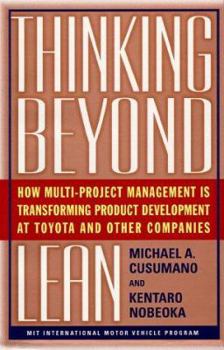Thinking Beyond Lean: How Multi Project Management Is Transforming Product Development at Toyota and O
(Part of the Les Réalités de l'entreprise Series)
Select Format
Select Condition 
Book Overview
"Lean Thinking" has dominated product development and project management for over a decade. Now, however, a six-year study by MIT's International Motor Vehicle Program led by Michael Cusumano and... This description may be from another edition of this product.
Format:Hardcover
Language:English
ISBN:0684849186
ISBN13:9780684849188
Release Date:September 1998
Publisher:Free Press
Length:248 Pages
Weight:1.05 lbs.
Dimensions:1.0" x 6.4" x 9.5"
Customer Reviews
1 rating
Multi-Project - possible, 68% increasing in product development
Published by Thriftbooks.com User , 16 years ago
The basic idea is to create new products and share key components but to utilize separate development teams that ensure each product will differ enough to attract different customers." "If they follow multi-project thinking then they can try to maximize the chances that the organization will produce a stream of new product that cover a range of market segments and make the best possible use of R & D investment." Automobiles provide an excellent case study for multi-project discipline. Car companies have numerous products and lot of projects going simultaneously. A product can have 30,00 or more components and usually take a million or more engineering hours per project to develop. The speed to market depends on part on the degree of functional activities: concept generation (decide what to design), advanced engineering (determine how a new product fits with other products), product planning (create detailed designs for components and coordinate the development of major components), process engineering (design equipment and techniques for manufacturing), and pilot engineering (low volume experimental manufacturing). The balance is determine "what is optimal for the individual project versus what is optimal for the organization". Which function should companies keep centralized to take advantage of scale and scope economies by providing engineering services and components? Which functions should companies disperse among projects in order to maximize the distinctiveness and innovativeness of the individual projects? How much authority over budgets and personnel should a project manager have versus managers of functional departments? To what extent should companies seek a balance of functional with project management by grouping related projects together and then sharing some technologies as well as functions at least for clusters of similar projects? 1992-1993, Toyota adopted a strategy and structure specifically for multi-project management of product development. The matrix structure involves the interaction between the following personnel: division manager, platform general manager, chief engineer, and functional engineer. Yoshiro Kinbara, an executive vice president, was in charge of Future project 21 (FP21). Toyota recognized that sometimes organizations need review and overhaul to be competitive in a changing environment. Toy had become less efficient in internal communication and had come to need more coordination tasks than before to manage new product development. Second competitive advantages of Japanese auto makes decreased significantly, as the rising value of the yen had made Japanese products more expensive. In 1992, there were as many as 16 functional engineering divisions ( 7,000 people) and each had a functional manager. There were also about 15 projects proceeding concurrently. Each project had a chief engineer which had coordinate people in 48 departments in 12 divisions. "In theory, chief engineers at Toyota





